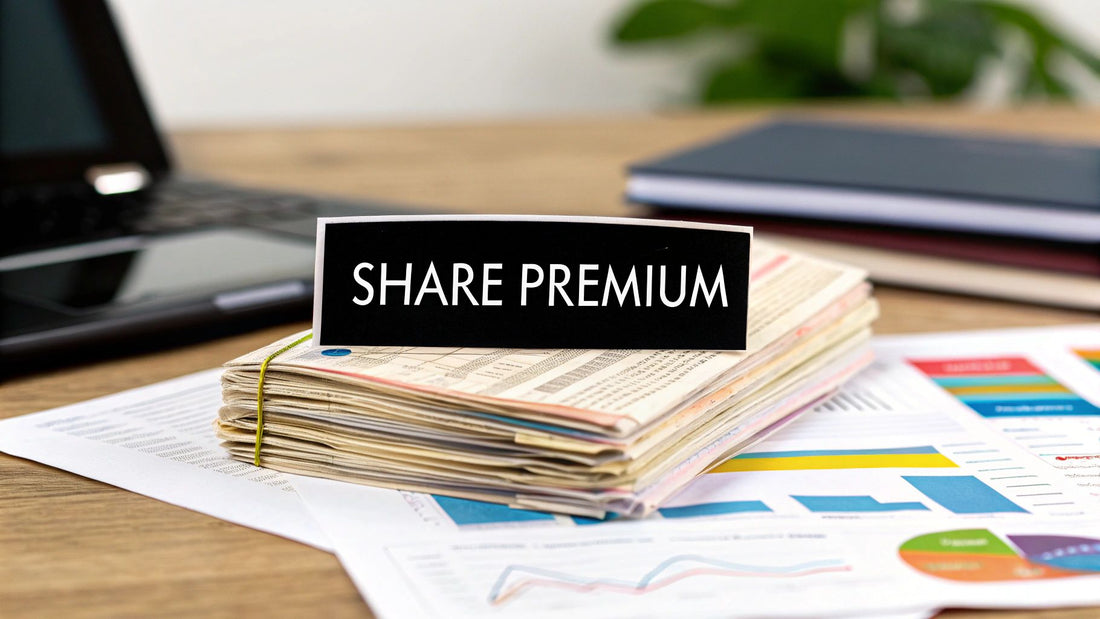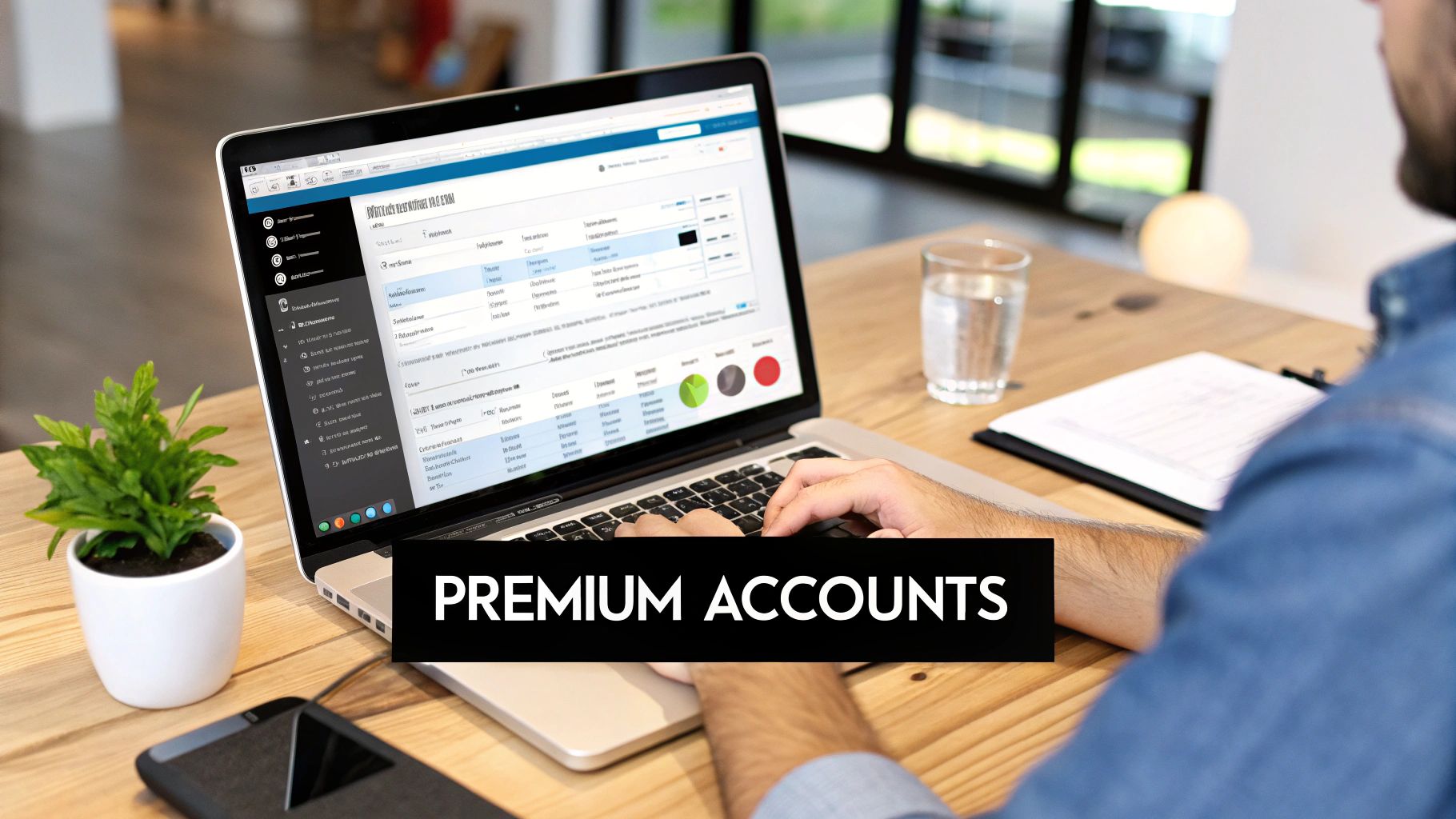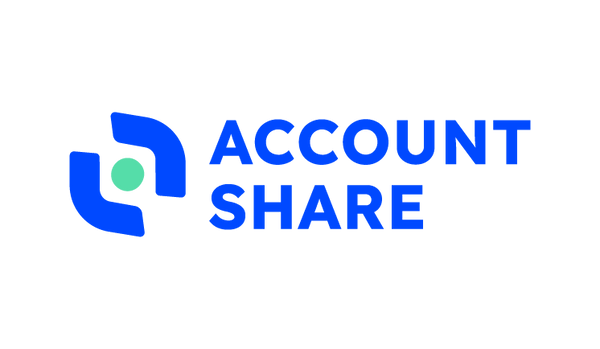
A Guide to Share Premium Accounts
Share
When a company issues new shares, the cash it brings in often gets split into two buckets. One is the official "share capital," and the other is the share premium account. This account is a special reserve on the balance sheet that captures any money paid by investors above the share's official, nominal price, often called its 'par value'.
Think of it as a vote of confidence. The par value might be a token $1, but if investors are willing to pay $50 per share, that extra $49 is a powerful signal. It reflects the market's belief in the company's future, and that premium gets parked right in this account.
What Exactly Is a Share Premium Account?

To really get a handle on a company’s financial health, you have to understand the share premium account. It’s a common point of confusion. This isn't revenue or profit; it's additional paid-in capital. It’s fresh cash injected directly from shareholders, sitting in the equity section of the balance sheet.
For founders, investors, or anyone analyzing a company's books, this distinction is critical. It shows how much capital has been raised from the market's enthusiasm, separate from the legally defined capital base.
Seeing It in Action: A Real-World Scenario
Let's break it down with a simple example. Say a company decides to issue 1,000 new shares to raise capital for expansion.
- The par value (the nominal price on the books) is set at $10 per share.
- But due to strong performance and market demand, the company sells these shares at a market price of $15 each.
The money doesn't just get lumped together. Here’s how it’s recorded:
- The share capital account increases by $10,000 (1,000 shares x $10 par value).
- The share premium account gets the extra $5,000 (1,000 shares x the $5 premium).
Key Takeaway: A healthy, growing share premium account is a fantastic indicator of investor confidence. It’s tangible proof that the market sees the company's value as being much higher than its nominal stock price suggests.
This table clearly illustrates how the proceeds from our example share issue would be allocated between the two accounts.
Share Issue Example Par Value vs Market Price
| Metric | Calculation | Amount |
|---|---|---|
| Number of Shares Issued | - | 1,000 |
| Market Price per Share | - | $15 |
| Par Value per Share | - | $10 |
| Total Cash Raised | 1,000 shares x $15 | $15,000 |
| Amount to Share Capital | 1,000 shares x $10 | $10,000 |
| Amount to Share Premium | 1,000 shares x ($15 - $10) | $5,000 |
As you can see, the full $15,000 raised is accounted for, but it’s split to maintain a clear and legally sound capital structure.
Why This Separation Matters
So why all the fuss about splitting the funds? This accounting practice is crucial for a couple of big reasons. First, it keeps the company's official 'share capital' stable and rooted in its legal definition, preventing it from being distorted by market hype.
Second, it creates a transparent trail. Anyone looking at the balance sheet can see exactly how much extra capital has been injected by shareholders over and above the stock's face value. This gives you a much clearer picture of a company’s funding history and financial stability.
For those who want to dive deeper into corporate finance topics, exploring specialized resources can be incredibly helpful. Financial blogs like Fundpilot's Financial Blog often provide detailed articles on capital raising, equity, and accounting, giving you a solid foundation for financial analysis.
Why Do We Even Have Share Premium Accounts?

The share premium account might seem like just another piece of modern accounting jargon, but it has a fascinating backstory. It wasn't dreamed up in a boardroom last week; it was born out of real-world financial pressures and some clever problem-solving. Knowing where it came from helps you appreciate it as a strategic tool, not just a box to tick on a balance sheet.
Its origins trace all the way back to 19th-century United Kingdom company law. Back then, companies trying to grow faced a serious hurdle. They needed to raise capital, but their official "par" value capital was often hit with heavy taxes and duties. Every time they wanted to raise more money by increasing that capital, they'd get slapped with higher costs.
This is where the share premium account came in as an ingenious solution. It created a separate bucket to hold any cash raised from investors above a share's nominal par value. This meant a company could pull in significant funding without touching its official, taxable capital base.
A Smart Way Around the Rules
Honestly, the development of share premium accounts was a direct response to fiscal and regulatory headaches. By creating this distinct reserve, companies could legally sidestep certain tax burdens while still following the capital maintenance rules meant to protect their creditors. It was a brilliant, and perfectly legitimate, move.
This history is so important because it shows that accounting rules often have a compelling "why" behind them. The share premium account wasn't just created; it evolved because real companies needed a smarter way to handle their finances. If you're curious about the nitty-gritty, you can discover more insights about the historical roots of this practice and its role in early company law.
This account is a classic example of financial innovation. It’s proof that accounting practices adapt to legal and economic pressures, creating tools that are still fundamental to corporate finance today. It’s a solution that has stood the test of time for over a century.
From Historical Fix to Modern Staple
So, what began as a clever workaround has become a standard—and incredibly useful—part of modern finance. While its original tax-avoidance purpose has faded, its role today is just as critical. It provides a clear, transparent record of the market’s confidence in a company, neatly separating the capital investors have put in from the profits the business has actually earned.
This journey, from a tax-efficiency tool to a measure of investor sentiment, really shows its lasting value. It’s a great reminder of a core financial principle: the structures we rely on today were often forged by companies in the past looking for flexibility, growth, and a competitive edge.
Alright, let's move from the theory and get practical. Where do you actually find the share premium account when you’re looking at a company's financial statements?
You won’t see it standing alone. It's always located within the Shareholders' Equity section of the balance sheet. Think of this section as the command center for a company's net worth, giving you the complete rundown of its capital structure.
Typically, the share premium account is listed right next to two other critical items: common stock (sometimes called share capital) and retained earnings. Looking at these three together gives you a crystal-clear picture of where the company's equity is coming from. Is it from investors putting money in, or is it from profits the company has held onto over time?
What to Look for in the Equity Section
From my experience, a large or consistently growing share premium balance is almost always a good sign. It's a strong indicator of high investor demand. It tells you the market thinks the company’s stock is worth much more than its simple par value, which is a classic trait of high-growth companies that are successfully raising money by issuing new shares.
Here’s a simplified look at how this might appear on a balance sheet. The image below shows a real-world example where it's called "Additional Paid-In Capital"—it means the exact same thing.

As you can see, it’s slotted right under the "Common Stock" line. Both of these are added together to calculate the total paid-in capital before retained earnings are even considered.
Key Takeaway: Finding the number is the easy part. The real skill is in understanding the story it tells about the company's funding history and how the market sees it. A big number here means investors were willing—even eager—to pay a premium, giving the company a healthy cash boost without taking on any debt.
The Critical Role of Accurate Reconciliation
It's absolutely essential to correctly identify and check every line item in the equity section. A simple mistake—like misclassifying funds or a small calculation error—can completely warp the view of a company's financial health. Those kinds of mistakes can have pretty serious fallout.
This is why companies perform a balance sheet reconciliation. It's a meticulous process of cross-referencing the numbers on the balance sheet with other financial records to make sure everything is accurate down to the last penny. If you want to get into the weeds of how to properly manage and verify every part of this crucial financial statement, this ultimate balance sheet reconciliation checklist is a fantastic, step-by-step resource.
Ultimately, knowing where to find and how to interpret share premium accounts really elevates your financial literacy. It helps you look past the raw numbers on a balance sheet and see the real story of a company’s success in raising capital and earning investor trust.
A healthy balance in a share premium account is a fantastic asset, but it’s more than just a number on a balance sheet. Think of it as a strategic war chest, not a slush fund for daily expenses. Strict rules fence in this capital, preventing it from being handed out as cash dividends. Instead, it's earmarked for specific, legally-defined uses that build real, long-term value for the company and its investors.
So, instead of propping up day-to-day operations, these funds are tapped by savvy finance teams to strengthen the company’s financial bedrock, fine-tune its capital structure, and reward shareholders without draining operational cash. It’s a classic move from the corporate finance playbook—reinvesting the market's confidence back into the business in a smart, strategic way.
Writing Off Share Issue Expenses
One of the most common and practical uses for a share premium account is to clean up the costs of issuing the shares in the first place. When a company goes through a funding round, it doesn't just get a check—it also gets a stack of bills.
These expenses can add up quickly and often include:
- Hefty underwriting fees for investment banks.
- Charges from legal and accounting firms.
- The cost of printing and distributing prospectuses.
- Listing fees required by the stock exchange.
Using the share premium to absorb these one-time expenses is a slick accounting move. It keeps these costs off the company's profit and loss statement, which prevents them from dragging down the reported earnings. This way, the net amount of new capital raised is reflected cleanly, and the company's core performance isn't muddied by its capital-raising activities.
In essence, the share premium account pays for its own creation. It’s a self-contained loop that preserves operating profits and gives investors a much clearer picture of the company's actual business performance.
Covering Premiums on Share Buybacks
Another key strategy is putting the funds to work during a share buyback (or share repurchase). Companies often buy back their own shares from the open market to boost earnings per share or to send a strong signal to the market that they believe their stock is undervalued.
Typically, the company has to pay a price higher than the original par value to get those shares back. The share premium account is perfect for covering the "premium" part of this cost—the amount paid over and above the shares' nominal value. For example, if a share with a $1 par value is bought back for $25, the $24 difference can be paid out of the share premium fund. This has long been a standard practice, though it's now facing fresh scrutiny, with some governments looking to tax capital reductions that follow such buybacks.
Issuing Bonus Shares to Stockholders
Perhaps the most shareholder-friendly use of a share premium account is issuing bonus shares. This is when a company gives existing shareholders extra shares, completely free of charge, based on their current holdings. A company might announce a "1-for-5" bonus issue, for instance, meaning you get one new share for every five you already own.
While this doesn't bring any new cash into the business, it does something important: it converts the share premium reserve into permanent share capital. This move boosts the total number of shares in circulation, which can make the stock more liquid and accessible to smaller investors by lowering the price per share. It's an excellent way to reward shareholders without a cash dividend, all while capitalizing reserves and strengthening the company's capital base. If you're curious about how companies handle the accounting for these non-cash transactions, you can dig deeper into various cost allocation methods and see how they affect financial reports.
How Share Premiums Reflect Market Confidence
A company's share premium account tells you more than just the story of a single successful stock offering. When you step back and look at the bigger picture, the total value held in these accounts across the entire economy paints a vivid picture of market health and investor sentiment. Think of it as a powerful barometer for confidence.
If you see a widespread trend where companies are consistently commanding high premiums, it’s a clear signal of a bullish, optimistic market. It means thousands of investors are willing to pay much more than a share's basic par value, which reveals a deep-seated belief in future growth across the board. This isn't just about one popular tech stock; it's a reflection of broad economic optimism. That flow of capital is what fuels innovation, funds expansions, and ultimately drives the economy forward.
A Macro View of Investor Confidence
The sheer scale of this confidence can be staggering. We're not talking about pocket change. It's a massive tide of capital pouring into equity markets, with a huge chunk of it being recorded as share premiums.
Recent data, for instance, really puts this into perspective.
In a clear show of investor optimism, United States equity funds saw their assets jump by roughly 20.1%, adding an incredible $3.3 trillion in value. In the same vein, euro area equity funds grew by 9.1%.
This massive inflow of money directly means that a substantial number of shares were sold at significant premiums. That, in turn, inflates the total value sitting in share premium accounts on corporate balance sheets everywhere. If you want to dig deeper into these numbers, you can explore the full private markets report from McKinsey to see how this confidence is shaping global finance.
Linking Capital Flows to Real-World Growth
This isn't just some abstract financial idea. The cash held in these accounts represents real, tangible investment in our economy. It's the money that builds new factories, finances groundbreaking R&D, and lets companies hire more people. Every time a company has a successful share offering at a premium, it injects fresh, unleveraged capital directly into the business ecosystem.
This creates a positive feedback loop that's fascinating to watch:
- A strong economic outlook makes investors feel more confident.
- Confident investors are willing to pay higher premiums for shares.
- Companies take that premium capital and use it to fund their growth plans.
- Successful growth then strengthens the economic outlook even more.
This cycle shows that share premium accounts are far more than just a line item in an accounting ledger; they are a critical part of the engine that drives a modern market economy. Of course, managing the security around these massive capital influxes and the related investor data is also a huge responsibility. For anyone handling sensitive stakeholder information, knowing a secure way to share passwords and other credentials is a non-negotiable part of good corporate governance.
By keeping an eye on the trends in these accounts, you can get a surprisingly accurate pulse on where the market is headed.
Frequently Asked Questions About Share Premium Accounts
As you get more familiar with the idea of a share premium account, a few common questions always seem to pop up. It makes sense. While the concept seems simple at first glance, the details can get a bit tricky. Let's walk through some of the most frequent questions I hear and clear up any confusion.
People often ask if this account is just a slush fund the company can dip into whenever it wants. Others get it tangled up with a company's profits. Nailing down these distinctions is crucial if you really want to understand how a company puts its capital structure together.
Can a Company Use its Share Premium Account to Pay Cash Dividends?
The answer to this is a hard no. This is probably the most critical rule to remember about share premium accounts. It might look like a pile of extra cash just sitting there, but legally, it's not considered profit. It’s classified as part of the company’s core capital—money that investors put in directly.
Here’s a good way to think about it: retained earnings are the profits a company has made from its day-to-day business. That's the money that can be handed out to shareholders as cash dividends. The share premium account, on the other hand, is a capital reserve. Using it for dividends would be like handing investors their own money back and calling it "profit," which is both misleading and illegal.
Key Insight: The rule here is all about protecting the company's capital base. By treating share premium as capital—not profit—it ensures that creditors are protected because the company can't just drain its foundational funding by paying it out as if it were earnings.
This isn't just a minor accounting detail; it's a fundamental principle that protects the financial health of the company's balance sheet.
What's the Real Difference Between Share Premium and Retained Earnings?
This is another question I get all the time, but the difference is actually quite straightforward once you know where the money comes from. The entire distinction boils down to their origin: one comes from investors, and the other is generated by the business itself.
-
Share Premium Account: This is the cash investors pay that is above a share's official par value. Think of it as external capital that comes in when a company issues new stock. It’s a reflection of investor confidence and the market's valuation of the company, not a measure of how well it's been running its operations.
-
Retained Earnings: This is the running total of a company's profits over its entire history that it has decided to keep and reinvest, rather than pay out as dividends. It’s a direct indicator of the company’s past profitability and its ability to create value.
If you need a simple way to remember it, just think of share premium as "paid-in" capital and retained earnings as "earned" capital. They both live in the equity section of the balance sheet, but they tell two completely different stories about a company's financial history. And if you're looking for ways to get more value from your own money, you might find some useful ideas in these 10 hacks to save money on subscriptions.
Do All Companies Have a Share Premium Account?
Not at all. A share premium account is only created when a company issues new shares for a price higher than their par value.
You often won't find this account on the balance sheet of mature, stable companies that haven't issued new stock in decades. On the flip side, it's a standard feature for businesses like:
- High-growth startups raising capital through multiple funding rounds.
- Tech companies launching an Initial Public Offering (IPO).
- Any established business that successfully sells new shares to investors.
Ultimately, the existence of a share premium account is a direct sign of a company's capital-raising strategy. It’s a clear marker of a business that is actively using equity markets to fuel its growth and ambitions.
Looking for a smarter way to handle your premium subscriptions? AccountShare provides a secure and easy method for sharing the cost of streaming, software, and AI tool accounts. By joining a sharing group, you can get full access to premium features for a fraction of the price. Start saving now at https://accountshare.ai.
